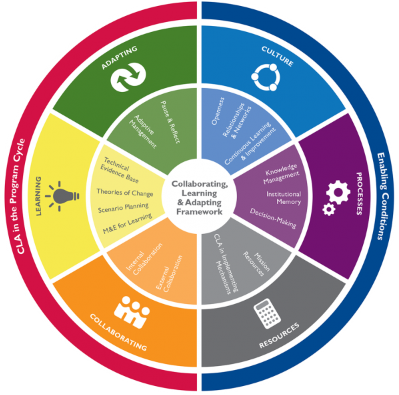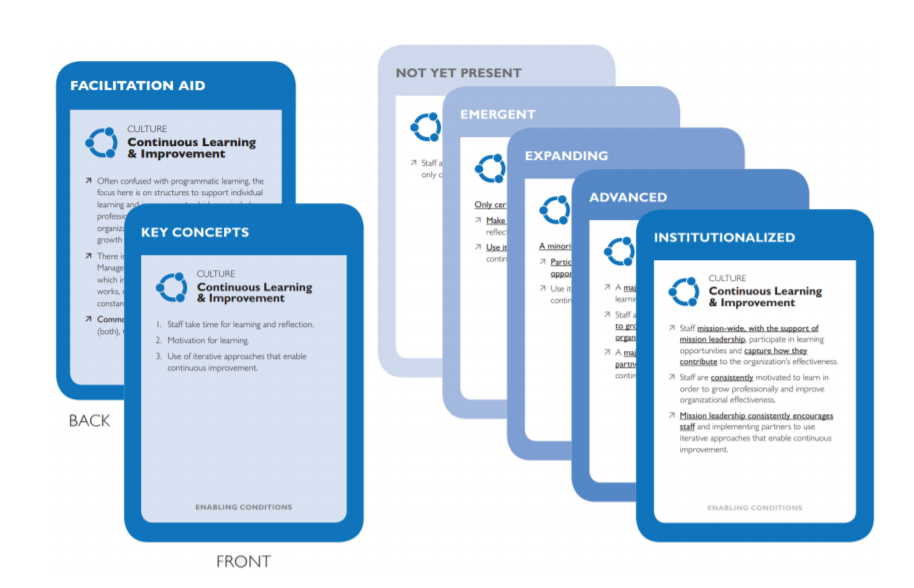The Birth of the Collaborating, Learning, and Adapting Maturity Tool
This summary of the CLA Maturity Tool was originally submitted as a case to the 2016 CLA Case Competition. It’s been repurposed here as a blog and includes some updates to reflect more recent developments.
USAID established Collaborating, Learning, and Adapting (CLA) as an area of practice in 2009, building on existing work within USAID on knowledge management, organizational learning, and adaptive management.
While CLA is not new to USAID missions, it often does not happen regularly or systematically and is not intentionally resourced. In 2014, USAID’s Bureau for Policy, Planning and Learning (PPL) awarded the LEARN (Learning and Knowledge Management) contract to support USAID missions and operating units as they integrate collaborating, learning, and adapting principles and approaches more intentionally throughout the Program Cycle. At the same time, the Bureau was planning to update USAID guidance (the ADS 200 Series) to emphasize the importance of learning and adaptive management practices to deliver more effective development assistance. Given that ADS updates would affect USAID missions most directly, it was critical to consult mission staff at the forefront of CLA integration to better understand how PPL and LEARN could better support them.
What Led to the Idea of Creating a Maturity Tool?
In 2015, PPL and LEARN conducted a stocktaking exercise with 14 USAID missions that had been early adopters of CLA. One of the key takeaways from this exercise was the lack of granular understanding about what CLA is and how it can be meaningfully integrated into Program Cycle processes. One interviewee told us, “Mission staff don't get CLA. The first inclination of staff is ‘Where's the application?’ and ‘What's the mechanism?’ They grapple to find something concrete.”
Moreover, even those missions with active CLA champions faced institutional challenges. These included:
- Perception that adapting was not possible given earmarked funding and contracting requirements;
- Mission cultures that were not conducive to learning and adapting;
- A lack of appropriate resources, including time, to enable CLA integration.
But an opportunity also emerged—PPL was planning to require missions to integrate CLA in their work in the updated ADS 200 guidance (scheduled for release in September 2016). This policy shift was based on feedback from missions that only requirements get prioritized (given time and resource constraints). But because of the institutional challenges mentioned, PPL and LEARN were concerned that CLA would become a box-checking exercise rather than an intentional, systematic, and resourced approach to designing and implementing better development programs. With these concerns in mind, PPL and LEARN carefully considered the following questions:
- How do we establish an approach to CLA integration that is easy to understand so it is clear what CLA is and how it supports better development?
- How do we create an approach to CLA integration that provides structure but also enables flexibility so each mission can determine what CLA approaches make sense in its respective context?
And how do we create a participatory process owned by the mission—not Washington— so CLA integration is something people see value in rather than something they feel forced to do?
To address these challenges, PPL and LEARN decided to create a maturity tool about Collaborating, Learning, and Adapting. The process of creating the CLA Maturity Tool is an example of the PPL and LEARN team ‘walking the talk’ and applying the principles and practices of CLA in our own work.
What is the CLA Maturity Tool?

So first, what is the CLA Maturity Tool? Now an easy-to-use set of cards (though this was not always the case; see this blog on the iterative process of developing the tool), the CLA Maturity Tool offers illustrative examples of what CLA looks like at different stages of maturity. The purpose of this tool is to help missions think more deliberately about how to tailor a CLA approach to fit their specific contexts and needs. USAID staff can use this customizable deck of cards within missions, as well as with implementing partners (IPs), to both assess current practice and plan for incremental improvements in CLA practices.
The CLA Maturity Tool consists of two decks of cards corresponding to two dimensions of CLA: CLA as part of the Program Cycle and the enabling conditions for implementing CLA.
- CLA in the Program Cycle: By using the stage cards to guide a conversation, teams can explore how well CLA is incorporated into the planning and implementation processes throughout the Program Cycle in order to improve their effectiveness.
- Enabling Conditions: The cards also encourage discussion of the conditions that can significantly influence how CLA shows up at a mission, including daily operating processes, organizational culture, and resourcing.
Within these decks, the tool covers 16 sub-components of CLA (those in the inner circle of the diagram to the right). Each has one key concept card and five stage cards that describe how the sub-component might show up in your work along a spectrum of practice ranging from Not Yet Present to Institutionalized (see example below).

The process of creating the CLA Maturity Tool is an example of the PPL and LEARN team ‘walking the talk’ and applying the principles and practices of CLA in our own work.
To read more about how an adaptive approach was used to develop the CLA Maturity Tool, read this blog.



